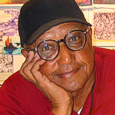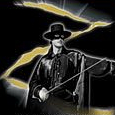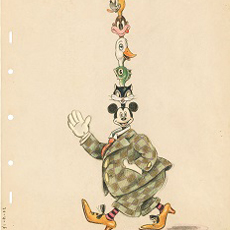What was it like to work at the Walt Disney Studio in the nineteen fifties, be in the apprenticeship program with the Nine Old Men, and maybe even attend story meetings with the Old Maestro himself?
Disney animator, artist, storyman and Disney Legend Floyd Norman spent nearly fifty years in Walt’s magic factory helping create a fair amount of that magic himself. From February 1956 to August 2000, he worked through three managements, and alongside a host of talented writers, artists, entertainers and craftsmen to help create the Disney legacy.
In his fantastic new book, My Animated Life, recently published by Blurb, Floyd collected dozens of animated stories, sharing his experiences from Sleeping Beauty to Toy Story 2, and guides us throughout the Disney and Pixar studios for a one-of-a-kind tour…
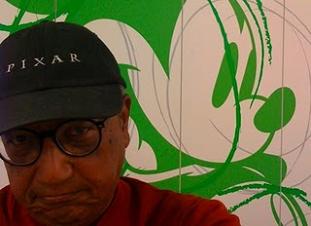
Animated Views: How did you come to the idea of writing this book?
Floyd Norman: That’s a long story, but I guess it begins with my speaking with the Disney old timers. I always wanted these great old guys to write a book. Not some intellectual tome, but simply stories about what it was like working at Disney in those remarkable early days at the studio. When I was a young kid I loved hearing those stories, and I knew that once these guys were gone, those wonderful stories would be lost forever. Sadly, few of the old guys ever got around to writing anything, and a huge chunk of Disney history was lost forever.
AV: Your career is rich of many different experiences, in animation at Disney, but also at other studios, and also in the field of publishing. Why did you choose to focus on your experience with Disney animation?
FN: First of all, I love Disney animation, but I also grew up on Disney comics. You can imagine how thrilled I was to be able to do both. Writing comics is a lot more fun. The story is yours and yours alone. When you write a movie, you’re often working with an army. Of course, a lot of good stuff can come out of a story team working together, but it can also be a headache of opinion and egos. With a few remarkable exceptions, my story work on feature films has usually been painful. However, when the process works, it works extremely well.
I also enjoyed working at other studios especially the smaller ones. This is where you do unique little jobs for education and television. Sesame Street animation came out of Pantomime Pictures back in the sixties. I loved animating that stuff. It was so creative and free. It was a studio totally free from foolish, meddling, no nothing executives screwing things up. I worked with an animation master named, Fred Crippen. Not as well known as the Nine Old Men, he remains one of my animation heroes.

AV: Do you envision writing other books on your other experiences?
FN: Sure, why not. I guess I’ll keep writing because I’ve nothing else to do. I remember Disney old guys retiring and supposedly going home to write. But none of them ever wrote a darn thing. For some odd reason, people who say they’re going to write, never seem to get around to doing it. Well, I’m going to write. I don’t know if anybody will bother reading it – but I’m going to write anyway. They’ll never be able to say, “Floyd never wrote anything.” This cranky old man still has many stories to tell.
AV: Can you tell me about the process of writing and editing and then publishing this book?
FN: Writing this book was an experiment, really. I had never published a book through this online process. Plus, because I wasn’t dealing with a mainstream publisher, I had total editorial and artistic control over my book. Of course, the downside remains, it’s difficult to market a product that’s not in the mainstream.
So much of the material was already there. I already had a pile of photographs I had taken during my years at Disney and Pixar. I didn’t have to interview anyone because I wrote directly from my memories at the studios. I never requested any studio support because, frankly, I didn’t need their support. Plus, studios always have an agenda. All they care about is making themselves look good. Major studios don’t really care about anything insightful. Mainly, they simply want to protect themselves. It’s the corporate beast at its worst.
AV: I love the tone of the book. Very friendly, just as if you’d take our hands and be our guide for a one of a kind tour.
FN: I think a book should welcome the reader. After all, we’re going to share something special. My first visit to the Walt Disney Studio was magical. I wanted readers of my book to experience a bit of the magic I felt when I first entered the gates over fifty years ago. Plus, I’ve adopted a conversational style that feels right to me. I hope readers respond to that.

AV: Your description of Walt Disney is somehow different from what we are used to read here and there. You mention him as being “self deprecating” and not as the stressed, and ill-tempered person he’s often described. Can you tell me more about YOUR Walt Disney?
FN: I enjoyed drawing cartoons about Walt Disney and I often portrayed him as this gruff, grumpy, old man stomping down the hallway as people scurried about in fear. That was my cartoon Walt Disney. In reality, Walt Disney was the nicest man I ever had the pleasure of meeting and working for. Not without faults, Walt was not a perfect man and he, like the rest of us could never be called perfect. However, Disney was an incredible leader who inspired everyone on his staff. It’s no wonder staffers were overcome with grief at his passing back in 1966. When we lost The Old Maestro It was as if the world had suddenly stopped. It was the end of an era at the Walt Disney Studio, and maybe even for the world.
A person once told me that he felt sorry for Walt Disney because the Old Maestro must have had the weight of the world on his shoulders running the company. This person couldn’t have been more wrong. Working animated Walt Disney. It was what he lived for. Walt took extreme delight in what he did and couldn’t get enough of it. Some might call Disney a workaholic who simply couldn’t stay away from the studio. However, the studio was his life, and he relished every moment he was on the job. Should you ask, who was the happiest worker at the Disney studio the answer would be easy. It was Walt Disney.
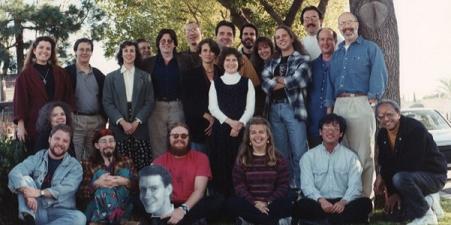
AV: My favorite animated film of the post-Walt era is The Hunchback of Notre-Dame, which you describe as the most sophisticated animated film you’ve worked on. Can you tell me more about it?
FN: When I first heard that Disney was thinking about making the Victor Hugo novel I thought, this has got to be the craziest thing I had ever heard. I also thought, I’ve got to work on this film.
Bold decisions is what separates the men from the boys, in my opinion. If a studio is to remain creative and vibrant, they’ve got to push the boundaries. they’ve got to go out on a limb or jump off the cliff. Doing The Hunchback of Notre Dame was a daring move by any stretch, and it shows the confidence that Disney had in its animation staff in the nineties. The creative team was fearless, and you have to be fearless if you’re to remain creative.
Now, it’s true that once in production, the film makers were encouraged by management to “tone things down”. Victor Hugo’s novel dealt with some pretty heavy themes, and Disney wanted to have it both ways. A bold, daring, provocative motion picture that would entertain the kiddies. Disney’s marketing campaign for the movie was themed “Join the Party”. The choice was not only disingenuous, it was just plain silly.
However, the songs by Stephen Schwartz and Alan Menken were inspired, and the musical score is a triumph. Of course, the powerful themes resonate throughout the story. The “ugly people” we often fear. The “despised minority” we don’t want entering our space. And finally, the corrupt leaders who feel they are doing God’s will. Powerful stuff for a Disney movie. If only the studio hadn’t wimped out and watered things down for the sake of commerce. This motion picture could have changed animation forever. Instead it simply shows when all is said and done, the Disney Company simply wants to make money.
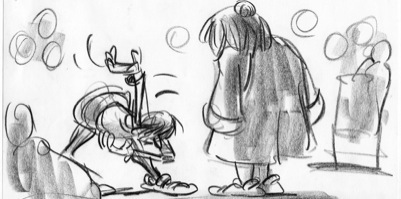
AV: You wrote you loved working on Toy Story 2. To you as a Disney storyman, what makes this story so good?
FN: A great film story grabs me right away. When producer, Ralph Guggenheim brought this film idea down to Disney in late 1996, I knew I had to work on this movie. most sequels are simply contrived to make an easy buck. This was truly a great story. The story beats were solid. Woody is kidnapped. The toys have to rescue him, and when they finally do – he doesn’t want to be rescued. An inspired, unexpected twist.
However, what makes any story sparkle is how it’s told, and the Pixar storytellers are the best. I’ve often read that our film was a wreck, and had to be saved at the last minute. I totally disagree with those opinions. While it’s true there were problems, I always knew the problems could be fixed, and even had a late night meeting with Pixar story ace, Joe Ranft. I knew no one would listen to me, but Joe Ranft already had a reputation as a story guru. I knew Joe was the “secret weapon” that would push the film over the top. Once Joe Ranft, Pete Docter and Andrew Stanton came on board, Toy Story 2 was destined to become a masterpiece.
AV: What do you expect from Toy Story 3?
FN: I expect Toy Story 3 to be the perfect wrap up for this wonderful series. I’ve seen much of the film, including story reels and stuff. The film is darn good, and I’m sure audiences will love it. One thing is missing, however, and can never be replaced. We lost the great Joe Ranft before the film began production. How do you replace Joe Ranft? The sad answer is, you can’t.

AV: You wrote about the importance of the voices to help create the story (with Sterling Holloway or Jodie Benson). Can you tell me about how a voice artist can help you shape a story?
FN: You’ve given me two different worlds. Sterling Holloway doing voice work on The Jungle Book, and Jodie Benson voicing Barbie in Toy Story 2. Luckily, I was on hand for both recording sessions. We recorded Sterling Holloway back in 1966 in the large Studio A, and we recorded Jodie Benson in late summer 1998 in Studio B on the Disney studio lot. I love great voice actors, and by that I mean people who can give a great performance with their voice alone. You’d be surprised how many movie actors cannot act. I know. I’ve heard their auditions, and you’ve probably seen their movies.
In the old days, Walt Disney found many of his great voice actors on the radio. Some of the finest Disney voice people never had a highly visible screen career. Their voice was the perfect instrument. I miss the old codgers who cut their acting teeth in the radio business. When you’ve got a master in the recording booth, you can almost see the scene come alive in your head. They truly inspire the film makers. Those old pros were simply wonderful, and I would choose them over a big shot Hollywood star any day.
AV: How do you feel regarding Disney’s latest animated productions like Princess and the Frog? Do you see it as a new start?
I don’t regard the film as a “new start”. After all, animation never really ended. A few bone headed executives made stupid decisions, but Disney animation never died. Maybe the careers of the executives died, and rightly so.
No, Disney finally produced another remarkable traditional, hand drawn animated film. And, it’s a darn good one. The more I watch the film the more I like it. The cartoon geeks said this film would have to be a masterpiece in order to save Disney animation. Well, Disney animation doesn’t need saving. It’s here, it’s always been here, and it’ll always be here. Whether Disney wants to support animation, is a corporate choice. Even if the big corporation dies – Disney will live on. Art has a way of doing that.
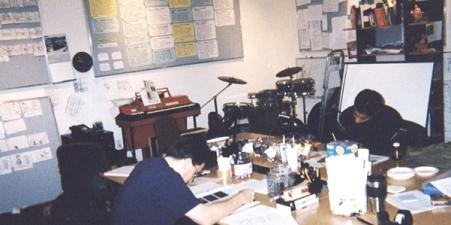
AV: In your book, you wrote that Monsters, Inc was an “opportunity to put more Disney-like entertainment on the screen, even if it didn’t come from Disney”. To you, what is “Disney-like” entertainment?
FN: That’s easy. Films that have warmth, humor and charm. When you create characters that are real you let people fall in love with them. Not only that, people will continue to love them for a lifetime. This is an amazing gift that you give it to the kids. A gift that you give it to the world. Walt understood that, and he taught it to his “boys”. The “old boys” taught it to the new generation of kids that would eventually run Pixar Animation Studios. And people wonder why Pixar’s films are so good?
AV: During Walt’s time, Disney artists were staff artists. Now, they come from everywhere, from different studios and very different kind of productions. Because of that, do you feel it more difficult to maintain the Disney style? How do you help Disney remain Disney?
FN: Of course, even in the old days artists came from everywhere. What mattered was whether the artists were a “good fit” for Disney. If you worked for Walt, that meant doing things his way. If an artist was an individualist, then he or she had better move on. You were creating Walt’s product not your own. We all know that Walt Disney created an amazing in house staff as far back as the thirties. Disney knew how to bring creative people together and get the best out of them. He was the conductor, the maestro.
However, I’ve no problem with artists new to Disney joining the team. When we made The Hunchback of Notre Dame back in the nineties, many of our artists came from Europe, the UK and Canada because Disney was growing short on personnel. Adding staff from outside the studio can actually be an asset. These non-Disney artists often bring a fresh and unique approach. These ideas can be good for the production. Disney will have no problem remaining Disney as long as the leadership of the company not lose sight of the legacy Walt built.

AV: Retirement doesn’t sound like it is part of your vocabulary! So, what are your projects?
FN: I would love to continue making films, but filmmaking is an expensive enterprise and not something one can do out of their own pocket. Well, actually you can with today’s amazing technology. However, I’ve already done the independent filmmaking thing when I was a young man, and I don’t care to go through that again. I still love film making of course. It’s just that I don’t want to work that hard.
As I said earlier, I was totally bummed out that the old guys I so admired never got around to writing their books. I would have loved a book from Ward Kimball or Carl Fallberg. Boy, the stories these guys could tell. I’m not going to let that happen on my watch. While I’m nowhere near their legendary status, I will continue to tell the wonderful Disney stories that have excited and inspired me.
Plus, I’ll be keeping my eye on technology. Who knows what new device could come along? What platforms might afford animation a brand new home. You can bet Walt Disney would be excited about innovation were he around today.
Finally, it wouldn’t surprise me to think of Walt Disney and Apple’s Steve Jobs sitting around and planning some awesome new project that would – dare I say it – change the world.




